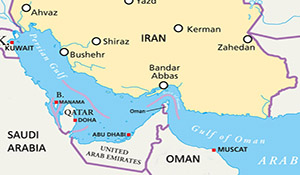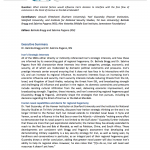Commerce in the Strait of Hormuz

Question: What internal factors would influence Iran’s decision to interfere with the free flow of commerce in the Strait of Hormuz or the Bab el Mandeb?
Author | Editor: Bragg, B. & Pagano, S. (NSI, Inc).
Iran’s Strategic Interests
All of the SMEs either directly or indirectly referenced Iran’s strategic interests, and how these are informed by its overarching goal of regional hegemony. Dr. Belinda Bragg and Dr. Sabrina Pagano from NSI characterize these interests into three categories; prestige, economic; and security, all of which are moderated by domestic political constraints and pressures. Iran’s prestige interests center around ensuring that it does not lose face in its interactions with the US, and can increase its regional influence. Its economic interests focus on increasing Iran’s economic influence and security. Iran’s security interests include reducing threats from the US, Israel, and Kingdom of Saudi Arabia, reducing the threat from ISIL, and broadcasting strength and challenging US influence and position in the region. Its domestic constraints and pressures include resisting cultural infiltration from the west, delivering economic improvement, and broadcasting strength. Together, these interests, and Iran’s overarching regional hegemony goal (Guzansky; Bragg & Pagano), ultimately shape the strategies that Iran pursues, including its decisions regarding the Strait of Hormuz or the Bab el Mandeb.
Iranian naval capabilities and desire for regional hegemony
Dr. Yoel Guzansky, of the Hoover Institution at Stanford University and the Institute for National Security Studies at Tel Aviv University, discusses how Iranian strategic thinking on the sea is no longer limited to the Persian Gulf, but instead extends to intended naval bases in Syria and Yemen, as well as influence in the Red Sea or even the Atlantic—ultimately “making every effort to demonstrate that its naval power is not limited to the Gulf alone.” Guzansky further indicates that these are more than just aspirational statements; the Iranian Navy has already extended its reach to the Red Sea and Bab el Mandeb, as well as Pakistan, China, and South Africa. These developments are consistent with Bragg and Pagano’s assessment that developing and demonstrating military capability is a key security strategy for Iran, as well as being seen, by hardliners and conservatives in particular, as an integral part of their regional hegemony goal. Guzansky draws a similar conclusion, adding that greater naval power will also increase Iran’s ability to help its regional allies. However, he also notes that “[t]o do so, Iran will need vast resources it doesn’t yet have.”
Guzansky indicates that, historically, Iran has prioritized the development of asymmetric capabilities (including anti-ship missiles, mines, and small vessel swarms), to enable it to better confront the U.S. Navy in the Gulf. Iran can leverage these same capabilities, and others, to interfere with the flow of commerce in the Strait of Hormuz, and to a lesser extent, the Bab el Mandeb.
Internal factors influencing Iranian interference in the Strait or Bab el Mandeb
The contributors identified the following internal factors as potentially influencing Iranian actions in the Strait of Hormuz or Bab el Mandeb:
Iran’s revolutionary doctrine
- Frames Iran as involved in an existential fight against US imperialism
- Makes it critical for Iran’s leaders, particularly conservatives and hardliners, to demonstrate to the Iranian people that they will not be bullied by the US
- Supports and informs Iran’s goal of regional hegemony Domestic political competition
- The role of factions—conservative / hardliner; moderate/pragmatist—in the prioritization of Iranian interests and the preferred strategies for achieving these interests
- With an election coming up in May, conservatives have incentive to switch the domestic political focus from cooperation with the US toward confrontation, to both appease their base and put greater pressure on Rouhani
Economic conditions
- Slow pace of improvement following JCPOA leaves moderates such as Rouhani politically vulnerable, and creates the belief that their promised benefits of greater openness and cooperation were unrealistic
- As the salience of economic concerns wanes relative to prestige and security concerns for the Iranian public, there is a greater likelihood that leaders (both conservative and moderate) will employ more bellicose rhetoric with regard to the Strait of Hormuz
- Closing the Straits will have significant short-term negative economic consequences for Iran, and depending on international and US response, may have longer-term consequences for Iran such as the re-imposition of sanctions and loss of trade and foreign investment
- Given Iran’s current economic situation and growing dependence on oil exports, it is unlikely to take action to close the Strait or Bab el Mandeb, as doing so would harm their economic interest further and thus be self-defeating
Popular perception that the US is not living up to terms of JCPOA
- Plays into hardline and conservative narratives emphasizing Western (especially US) hostility and untrustworthiness, giving credence to their own economic strategy, which seeks to limit openness to the West
- Increases the likelihood that the balance between the economic costs of interfering with commerce in either the Strait of Hormuz or the Bab el Mandeb, and the perceived benefit of demonstrating Iranian power and status, may swing in favor of the latter
External factors influencing Iranian interference in the Strait or Bab el Mandeb
The contributors argue that external factors also play a role in Iran’s decision-making with respect to its activities at sea.
Competition with Saudi Arabia
- Saudi Arabia’s opening of naval bases in Djibouti and Eritrea affords it an advantage in the Red Sea area
- Iran may wish to do “more to limit the Saudis by pushing harder on the question of access/use of both straits” (Vatanka)
- Retaliation for Saudi’s restricting Iranian access to the SUMED pipeline and selectively blocking Iranian ships in the Bab el Mandeb, which has stifled Iran’s establishment of trade with Europe
- Iran has potential to weaken Saudi government domestically by disrupting oil revenues and thus creating the conditions for greater internal unrest and instability
- Iran’s support of the Houthis, including provision of supplies to which the Houthis already have access, may actually serve to signal to and threaten Saudi Arabia and demonstrate Iran’s reach
Use of proxies
- The “effective blockade on Yemen,” which Iran’s current naval capabilities cannot challenge, creates a barrier to Iran helping the Houthis
- The Houthis may not be particularly dependent on Iran, given that they already have many of the supplies it provides, and Iran is unlikely to provide additional forms of support
- Ultimately, “I don’t think the Houthis want their tail in the trap of the Iran-Saudi conflict anyways” (Ehteshami)
- Yemen imports 90% of its food, much of this using foreign shipping. Further reduction in security in the Bab el Mandeb would threaten this supply, and therefore is not in the interests of the Houthis.
US actions and rhetoric
- Reinforce the perception that the US acted dishonestly with regard to JCPOA, seeking to thwart Iran’s efforts to increase trade and foreign investment
- Given the current domestic political climate, both conservatives and hardliners, as well as moderates, have greater incentive to frame any US action relative to Iran as threatening and conflictual, rather than cooperative
Iran’s strategic calculus with respect to interference in the Strait of Hormuz
Alex Vatanka, an Iran scholar from the Middle East Institute, and Bragg and Pagano of NSI indicate that closing the Strait may in fact work against Iran’s own interests, since it is as dependent on oil moving through the Strait as are its rivals. In this way, Iran may gain more value from threatening to close the Strait, which may increase oil prices, than from actually closing the Strait, which is sure to result in retributive actions, most likely from the US. As Vatanka indicates, a continued US presence in the Strait all but guarantees that Iran will use this strategic lever sparingly, if at all. Both Guzansky and Pagano and Bragg suggest that factors enhancing Iran’s likelihood of plausible deniability (use of asymmetric methods or proxies), by reducing the expected costs of such action, may, if other interests are met, instead increase the likelihood that Iran will choose to interfere.
Iran’s strategic calculus with respect to interference in the Bab el Mandeb
The strategic calculus for Bab el Mandeb may be different, as Bragg and Pagano note. There are two issues to consider with respect to potential Iranian interference in the Bab el Mandeb. These relate to both its capability to interfere and its motivation to do so. At present, Iran’s degree of control over the Houthis is unclear, and thus its ability to exact precise control over their activities may be limited. However, if Iran’s continued support of the Houthis gains them greater influence, then we can expect that the present Houthi control over Yemen’s ports might translate into greater Iranian interference in the Bab el Mandeb, assuming appropriate motivation.
This is where the Iranian calculus for the Strait of Hormuz and the Bab el Mandeb may come to differ. If Iran continues to pivot its trade toward greater interaction with China, India, and Southeast Asia, it will become less dependent on commerce in the Bab el Mandeb. Ehteshami also indirectly provides some support for this conclusion, indicating that the Bab el Mandeb represents more of a security rather than economic interest to Iran. As Bragg and Pagano indicate, this trade pivot means that the Bab el Mandeb becomes less strategically important to Iran as a source of economic power, but more strategically useful to Iran as a source of economic and other manipulation of its perceived rivals, such as Saudi Arabia. Moreover, this is accomplished while making Iran less vulnerable to economic and other manipulation from its rivals through selective blocking of its own ships’ passage. Iran does not have the same alternatives in the Strait of Hormuz, and cannot decrease its dependence on an open Strait for sea transportation, critical to its economic well-being. In these ways, the strategic calculus in favor of Iranian interference in the Bab el Mandeb, but not the Strait of Hormuz, may come to evolve over time in favor of increasing interference or escalation. For the time being, however, as Guzansky notes, this may be a more distant reality, given some of the present limits of Iran’s naval force, including the effective blockade on Yemen that prevents Iran from accessing Yemen’s shores.
Despite these challenges, Iran’s focus on achieving and maintaining regional hegemony, and its naval and other actions toward this goal, should not be ignored. Iran is increasingly likely to pursue strategies such as new trade partnerships that minimize the harm that its rivals can inflict, as well as those that enable it to increasingly project power, whether through the use of proxies of otherwise. As Guzansky notes, “unless improved Iranian naval capabilities receive a proper response, Iran in the future will be able to threaten crucial shipping lanes, impose naval blockades, and land special forces on distant shores should it deem it necessary.”
Contributing Authors
Bragg, B. (NSI), Ehteshami, A. (Durham University), Guzansky, Y. (Hoover Institution, Stanford University, & Tel Aviv University); Pagano, S. (NSI); Vatanka, A. (Middle East Institute & Jamestown Foundation)

Comments